Round three brought the interesting match between the U.S.A. and D.P.R.
Korea. The representative from the US is well known veteran professor
Thomas Hsiang. He is an amateur player of very high level indeed. The
game Hsiang played as black against the representative from D.P.R.
Korea drew a lot of attention, it was the first real test for both of
the participants. I showed the game to Ogata 9p who had dropped by
unofficially (and nobody recognized him). Ogata sensei often hummed in
agreement with the moves appearing on the board. "Wow, these people are
studying a lot, that's for sure" Ogata sensei was most impressed by the
up to date knowledge of Joseki both players put on display.
Although the game was rather difficult right from the start when
watching it from the side lines it seemed a lot as if Tae Won Jo from
D.P.R. Korea was not particularly having a hard time. No sweating,
grunting or frowning while bending over the board for Tae Won. Loosely
holding his fan in one hand, legs crossed, a relaxed Buda image comes to
mind to express Tae. Hsiang's posture, on the other hand, was not such a
blatant display of lack of pressure.
Although Hsiang was most willingly to cooperate for an gobase-interview
actually sitting down to talk with him turned out to be easier said than
done. In the 5 minutes we finally could find Hsiang told a little bit
about how his go career started out.
"I started to play at 16 during summer break. I was doing a summer job
and didn't have much else to do so a friend taught me how to play. I
remember that we started out him giving me 25 stones handicap. At the
end of summer, however, it was I giving him 9 stones and beating him
too.
"As an undergraduate I almost did not play at all and my level stayed
about the same I guess but when at Berkeley University I had the
opportunity to play with really strong Korean and Chinese players which
helped a lot. I remember a Mr. Kim who was enlisted in the army and
stationed at Alameda. We would get together in our free time to play a
game or two. I think that at that time I grew the most."
Listening to Hsiang explaining about the strength of players of Asian
heritage I got the impression that the "homeboy" U.S. players are not
yet up to snuff, Michael Redmond being the exception than, of course.
When I mentioned this to Hsiang he immediately replied "No, that is not
the case. Players like Ron Schneider, Ned Phipps and Don Wiener
all have a very high level. I surely cannot say that I am stronger or anything."
Every round 10 games are recorded which you at sometime should be able
to download from the Ki-in site. Right now there still are some problems
with the new Swiss paring system software. The people who should be busy
getting the games up are working around the clock to have to tournament
go smoothly.
This game, however, is not one of the officially recorded ones. When the
game had finished I asked Tae Won to manually input it for me which he
most kindly did. Remember, if you find yourself in a situation like this
and you want a game record always ask the *winner* to help you?
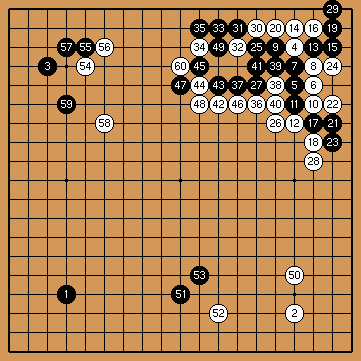
| Event |
26th WAGC, round 3 |
|---|
| Date |
2005 May 25 |
|---|
| Place |
Nagoya, Japan |
|---|
| Black |
Thomas Hsiang, USA |
|---|
| White |
Jo TaeWon, D.P.R. Korea |
|---|
| Commentary |
Ogata Naoto, 9p |
|---|
| Game record |
|
|---|
Figure 1: 1-60
The upper right corner is an example of "living joseki". Meaning that
all possibilities are not yet completely explored in this new variation
and that pro's are spending a lot of time studying it. It does appear
in recent games quite a bit. Once each and every sidetrack has been
explored this big-scale joseki will probably be put back on the shelf
again. In the mean time it certainly can be a treat for joseki lovers,
understanding exactly what is going on however?..
Black 35 feels a bit risky according to Ogata, jumping to 43 was his
first idea but when looking some more he agreed that 35 seems playable
too. White only plays at 56 because he can aim at the cut of 60.
Strictly speaking in terms of "the direction of play" white 56 is not
correct, the upper side holds little attraction for white. "What white
really would like to do is to try to make his stones come out nicely is
to start the Nadare "avalanche" joseki all over again."
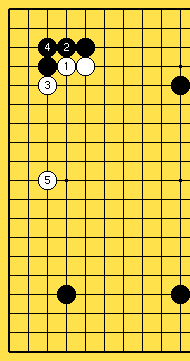

Diagram 1
Ogata sensei explained, "If things would develop like (dia 1) this white
is happy and satisfied. He lets black get the top but in return lays
claim on the left side which is much more interesting for him." Ogata
studies the board some more and suddenly hurries to continue " But, but,
but, black 4 is a bit slack and too cooperative a move to expect from
black.
Diagram 2
He'll play like this (dia 2) and hane with 4 starting the small
avalanche. Now since black already has some stones at the top this
variation might very well turn out to be profitable for him. All in all
how to play with game move white 56 is not an easy matter to decide."
The game continues on the laptop in front of Ogata 9p who goes like "He
does what, he cuts immediately?" when talking about white 60. Since
the justification for white 56 is the threat of this cut it only seems
natural to go there right away. Ogata sensei, however, felt that it was
a little early but when asked right out "is this way of playing bad?"
he answered, "no, that cannot be said, the only thing I can say with
certainty is the I'd feel reluctant to play there this soon."
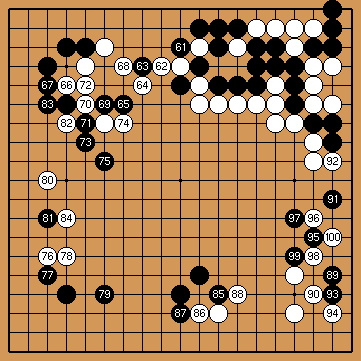
Figure 2: 61-100
Black 73 at 82 would be more solid. 73 is not impossible but Ogata felt
that it was "playing on the edge"
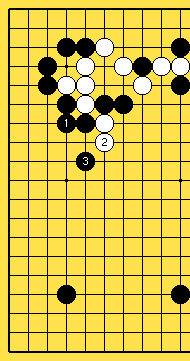
Diagram 3
Instead of black 73 diagram 3 shows a more steady way of playing.
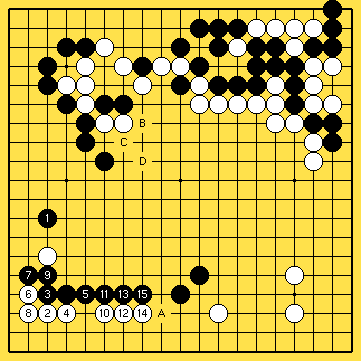
Diagram 4
Black 77 and 79 are one correct way of settling the left. Black also could go
with diagram 4. If after black 15 white answers at the bottom with A
black will play the brilliant squeeze starting from B, white C black D.
This would give black a very good game.
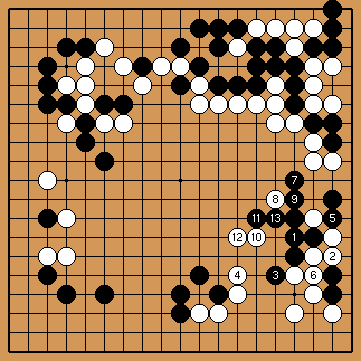
Figure 3: 101-113
When black gets to play at 113 it becomes clear that his stones are not
going to die. The flow of the game, however, for some time has been
favorable for white who eventually made this game his (W+11.5).
By beating the representative from the U.S. Tae Won really showed the
world that at 17 he is by no means a player to be taken lightly.
When asked about Tea Won, Hsiang had the following to say. "In my
opinion the player from D.P.R. Korea certainly has a shot at the title.
I estimate that his level is right up there with China, Korea and Japan.
Personally I'm routing for Kikuchi, however, he is such a fantastic
player but I'm afraid that (at his advanced age of 75) it will be very
difficult for him to be victorious here."
There could be no doubt about the Truth of Hsiang's assessment of Tae
Won's strength. D.P.R. Korea beat the number one seed and favorite South
Korea! As Japan lost to China this year's tournament might very well
boil down to a duel between North Korea and China.
| 







